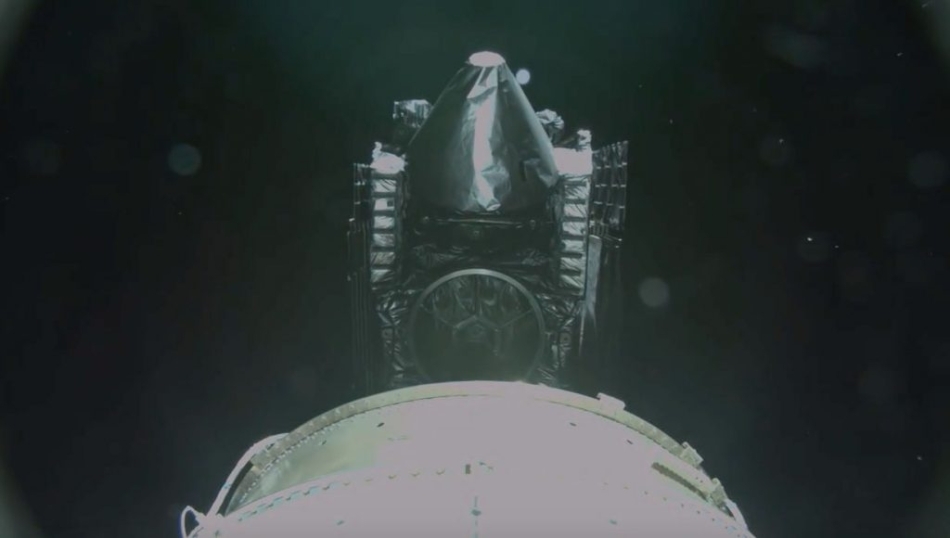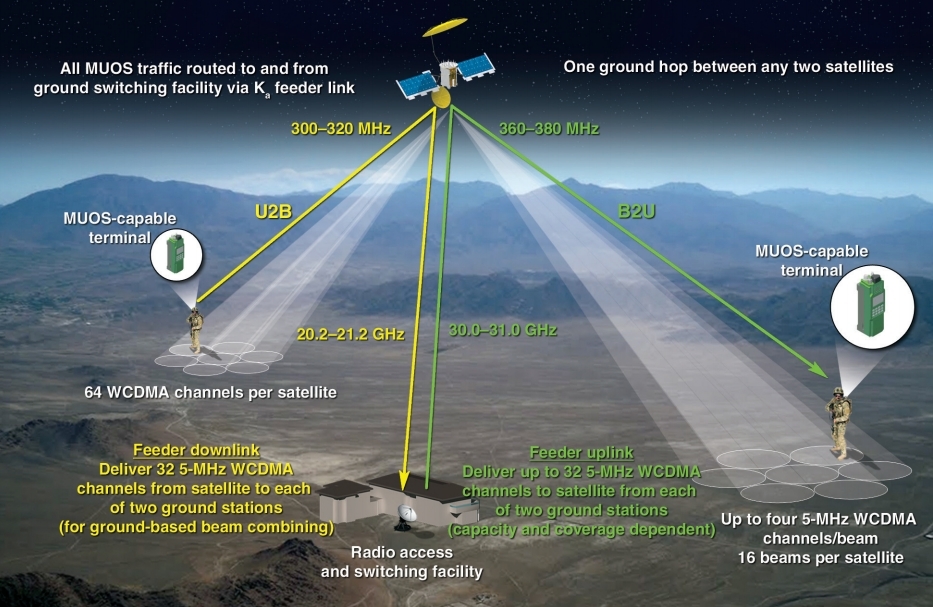From the last forces into orbit

Technique breaks at all. Now the American military communications satellite MUOS 5, whose main engine went down in the first days after its launch, is trying to get into geostationary orbit above our heads. Engineers do not give up and are still trying to bring it into the desired orbit using low-powered orientation engines. And we can follow this cosmic drama.
A little about the satellite
MUOS 5 is the fifth satellite of the Mobile User Objective System military communications system. Geostationary satellites together with ground stations provide communication around the world:

')
Four MUOS satellites are already working as intended, and the fifth was to go into position over the Indian Ocean (72 ° E) and serve as a backup. Legacy UFO in the picture - old Ultra High Frequency Follow-On satellites. The MUOS satellite operates in the 300-320 and 360-380 MHz bands and has 64 WCDMA channels with a channel width of 5 MHz. Technologically, this communication system is based on 3G commercial communications, of course, with military modifications.

An interesting feature of satellites are gilded wire antennas.

A smaller, 5.4 meter diameter is used for obsolete communication networks (292-318 MHz), and a 14-meter antenna will provide ten times more bandwidth.

The mass of one satellite is 6740 kg. The total cost of the MUOS program is estimated at $ 7.7 billion.
Launch, flight and crash
MUOS 5 was launched on June 24 on the most lifting version of the Atlas V launch vehicle - 551. Short launch video:
Long:
The accelerating block “Centaurus” brought the satellite to a geo-transfer orbit of 390335654 km with an inclination of 19 °. Amateur astronomers were even able to photograph the upper stage and the satellite shortly after separation. The blurred spot in the picture is the drainage of the tanks of the upper stage from fuel, oxidizer and pressurized gas so that the Centaurus does not explode in space.

From the geosynchronous orbit, MUOS 5 was supposed to accelerate by ~ 1,400 m / s and raise the pericenter (the lowest point of the orbit) to ~ 36,000 km. Relatively small propulsion of a sustainer engine meant that it would have to be done in several stages.

The first five days everything went well. The orbit has risen to 1524935710 km, and the inclination has decreased to 9.8 ° (in order to reach the geostationary orbit, the inclination needs to be zeroed). Amateur astronomers recorded the flickering of a satellite with a period of 5 minutes, which is typical of normal rotation in the geo-transition orbit of satellites on the A-2100 platform of Lockheed Martin. Only 600-700 m / s remained to the geostationary orbit target, but around the 5th of July the satellite orbit change stopped, and already on July 8, the news sites had information about the crash of the satellite's main engine. MUOS 5 was in big trouble.

What happened?
In an official report of the US Navy, which is the customer of the system, it says about the complete failure of the main engine, but the immediate cause of the accident is not called. What do we know about the MUOS 5 engine? Surprisingly enough - a lot. On the satellite is the main engine BT-4 manufactured by the Japanese company IHI Aerospace.

With a mass of 4.5 kg and a length of 0.65 meters, the BT-4 has a thrust of 46 kg and runs on a heptyl-amyl fuel pair. The engine performed well on a multitude of geostationary satellites and was placed on the cargo ship Cygnus, which flies to the ISS.

The last crash of this engine, judging by the information available on the Internet, occurred in 2010 - then it took the AEHF-1 satellite (also American, military and connected) more than a year to reach the geostationary orbit.
How can MUOS 5 get to the geostationary orbit?
Unfortunately, MUOS 5 does not have electrojet (ion, plasma) engines, on which it could, albeit slowly but fairly effectively, get to the geostationary orbit. The only thing left for him is the engines of the orientation system - 12 MR-103G with a load of 100 grams each and 6 MR-106L with a load of 2.2 kg each. Orientation engines are directed in different directions, therefore only part of them can be used to lift the orbit at a time. Another problem is that, unlike BT-4, which runs on the heptyl amyl fuel pair, orientation engines work on the thermal decomposition of heptyl only. It is simpler, but such engines have a lower specific impulse and spend more fuel on acceleration for the same 600-700 m / s. Worse, the amyl oxidizer in the satellite can no longer be used in any way, and it will have to be dragged with dead weight, still spending additional fuel on its acceleration.
What is happening now?
According to reports of amateur astronomers, the satellite appears later than it is supposed to by the parameters of the orbit. So, he maneuvers, trying to raise the orbit on low-power maneuvering engines. This will have to be done for a very long time, with a total revolution time of 940 minutes after the maneuver, it appears later only by ~ 400 seconds, which indicates a very small increment of speed. Obviously, since the satellite is not declared lost, then the engineers still hope to pull it into geostationary orbit. But you have to pay a lot for this - increased fuel consumption means a serious reduction in the lifetime of MUOS 5 in geostationary orbit. Because of the impact of the moon, it is necessary to constantly spend fuel there in order to remain at the desired point of standing, and when the fuel runs out, the satellite goes into an orbit that is unsuitable for use.
If you are interested in the drama MUOS 5, then you can follow its orbit parameters, for example, here . Increasing the perigee height means that the satellite changes its orbit. If (when) it is in orbit ~ 35500x36000 km with an inclination of ~ 5 ° (the parameters are taken from the MUOS 4 satellite and must be typical for the grouping), then only then its long and difficult road will be completed successfully.
Sources:
- Satellite data , spaceflight101 crash article
- The topic on the forum magazine "Cosmonautics News"
- MUOS 5 posts in the amateur satellite tracking station blog
- Posts ( one , two ) with orbital parameters
Other publications about space incidents on the tag "cosmic incidents"
Source: https://habr.com/ru/post/396697/
All Articles